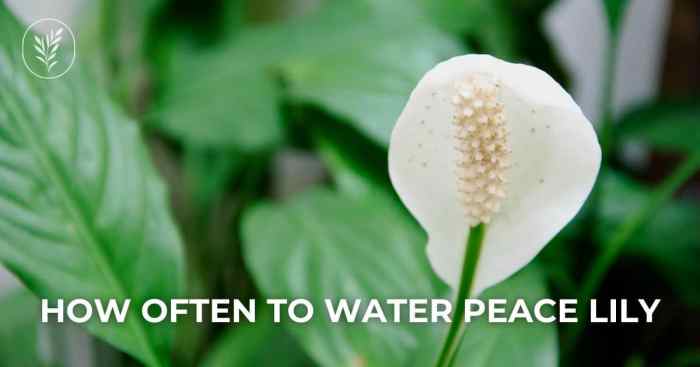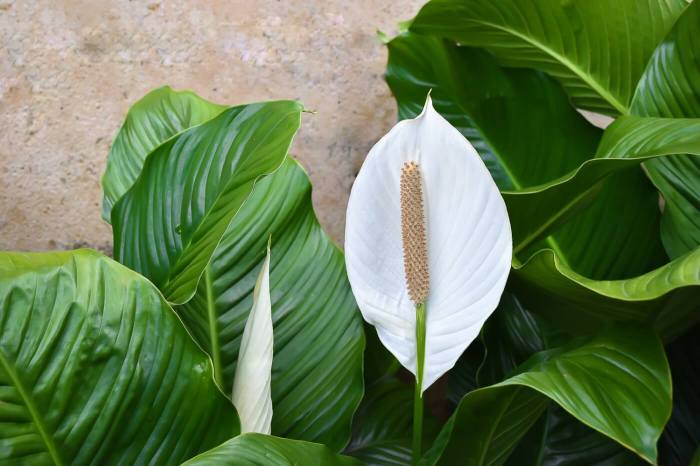How Often to Water Peace Lily Plant
Understanding Peace Lily Watering Needs
How often to water peace lily plant – Peace lilies, known for their elegant blooms and air-purifying qualities, require careful watering to thrive. Understanding their specific needs is crucial for maintaining their health and beauty. Several factors influence how often you should water your peace lily, and mastering these will lead to a happier, healthier plant.
Factors Influencing Watering Frequency
The frequency with which you water your peace lily depends on a combination of factors. These include the size of the pot, the season, the humidity levels in your environment, and the type of soil used.
- Pot Size: Larger pots retain moisture longer than smaller ones. A larger pot will require less frequent watering.
- Season: During warmer months (spring and summer), peace lilies generally require more frequent watering due to increased evaporation. In cooler months (autumn and winter), watering needs decrease significantly.
- Humidity: High humidity reduces the rate of soil drying, meaning you’ll need to water less frequently. Low humidity accelerates drying, necessitating more frequent watering.
- Soil Type: Well-draining potting mixes dry out faster than those that retain more moisture. A well-draining mix is crucial for preventing root rot.
Signs of Underwatering and Overwatering
Recognizing the signs of both underwatering and overwatering is essential for maintaining a healthy peace lily. The following table summarizes the key differences:
| Symptom | Underwatering | Overwatering |
|---|---|---|
| Leaves | Dry, crispy, brown leaf tips; wilting leaves | Yellowing leaves; soft, mushy leaves |
| Soil | Completely dry to the touch | Soggy, waterlogged; may smell foul |
| Plant Appearance | Drooping, overall wilted appearance | Slow growth; possible stem rot |
| Recovery | Responds quickly to thorough watering | May require repotting in fresh, dry soil |
Watering Frequency for Different Growth Stages

Source: homefortheharvest.com
Watering frequency also varies depending on the growth stage of your peace lily. Seedlings require more frequent, but lighter watering to maintain consistently moist soil, avoiding both dryness and waterlogging. Mature plants, having a more established root system, can tolerate slightly longer periods between waterings but still require consistent moisture.
Assessing Soil Moisture
Accurately assessing soil moisture is key to preventing both underwatering and overwatering. Several methods can help you determine when it’s time to water your peace lily.
Methods for Checking Soil Moisture
Two reliable methods for checking soil moisture are the finger test and using a moisture meter.
- Finger Test:
- Insert your index finger about an inch into the soil.
- If the soil feels dry, it’s time to water.
- If the soil feels slightly moist, wait a day or two before watering again.
- If the soil feels soggy or wet, your plant is overwatered.
- Moisture Meter:
- Insert the probe of the moisture meter into the soil.
- Read the meter’s indication of soil moisture level.
- Follow the meter’s instructions for appropriate watering based on the reading.
Importance of Well-Draining Potting Mix
Using a well-draining potting mix is crucial for the health of your peace lily. It prevents the soil from becoming waterlogged, which can lead to root rot. A good potting mix should retain some moisture while allowing excess water to drain easily.
| Potting Mix | Properties | Advantages | Disadvantages |
|---|---|---|---|
| Peat-based mix | Retains moisture, slightly acidic | Good moisture retention | Can become compacted over time |
| Coco coir-based mix | Good drainage and aeration, holds moisture | Sustainable, good aeration | Can be more expensive |
| Perlite/Vermiculite amended mix | Improved drainage and aeration | Excellent drainage | May dry out quickly |
Comparing Watering Techniques
Top watering and bottom watering are two common methods. Top watering involves pouring water directly onto the soil surface, while bottom watering involves placing the pot in a tray of water and allowing the plant to absorb moisture from the bottom.
- Top Watering: Simple and convenient; allows for better control of watering amount.
- Bottom Watering: Helps to evenly saturate the soil; minimizes the risk of overwatering.
Environmental Factors and Watering
Temperature, humidity, and light levels significantly influence a peace lily’s watering needs. Adjusting your watering schedule based on these factors is essential for optimal plant health.
Temperature and Humidity’s Impact
Higher temperatures and lower humidity lead to faster soil drying, requiring more frequent watering. Conversely, cooler temperatures and higher humidity slow down drying, reducing the frequency of watering. For example, during a hot summer day, you might water your peace lily daily, while during a cool winter day, you might only water it once a week or even less.
Light Levels and Watering Frequency, How often to water peace lily plant
Bright, indirect light increases the rate of soil evaporation, necessitating more frequent watering. Low light conditions slow down evaporation, reducing watering frequency. Plants in bright, sunny locations will dry out much quicker than those in shady areas.
Seasonal Watering Adjustments
Watering needs vary significantly across seasons. During summer’s higher temperatures and increased sunlight, watering frequency should increase. During winter’s lower temperatures and reduced light, watering should be significantly reduced to prevent root rot.
Troubleshooting Watering Issues

Source: petalrepublic.com
Despite best efforts, watering problems can occur. Knowing how to identify and address these issues is crucial for maintaining a healthy peace lily.
Troubleshooting Common Problems
- Yellowing Leaves: Can indicate both overwatering and underwatering. Check soil moisture; adjust watering accordingly.
- Drooping Leaves: Usually a sign of underwatering; water thoroughly and monitor for improvement.
- Root Rot: Caused by overwatering; characterized by mushy, brown roots and foul-smelling soil. Requires repotting with fresh soil.
Reviving an Underwatered or Overwatered Peace Lily
An underwatered peace lily can be revived by thoroughly watering it until water drains from the drainage holes. For an overwatered peace lily, remove it from the pot, inspect the roots, remove any rotten portions, and repot it in fresh, dry soil.
Signs of Root Rot and Solutions
Root rot manifests as dark brown, mushy roots that easily pull apart. Healthy roots are firm, white, or light-colored. To address root rot, remove the plant from its pot, gently rinse the roots to remove excess soil, trim away any affected roots with clean, sharp scissors, and repot the plant in fresh, well-draining potting mix.
Long-Term Peace Lily Care: How Often To Water Peace Lily Plant
Establishing a consistent watering routine and employing good practices will ensure your peace lily thrives for years to come.
Establishing a Consistent Watering Routine
Regularly check soil moisture using the finger test or a moisture meter. Develop a schedule based on your plant’s needs, adjusting as needed according to environmental conditions and the plant’s growth stage. Consistency is key to avoiding both underwatering and overwatering.
Using Filtered or Distilled Water
Peace lilies are sensitive to chemicals often found in tap water. Using filtered or distilled water helps prevent mineral buildup in the soil, which can negatively impact the plant’s health.
Adjusting Watering Based on Plant Health
Regularly inspect your peace lily for signs of stress, such as yellowing or drooping leaves. Adjust your watering schedule accordingly, increasing or decreasing frequency as needed to maintain optimal plant health and vigorous growth. A healthy peace lily will display vibrant green foliage and regular blooms.
Essential FAQs
What type of water is best for peace lilies?
Peace lilies thrive with consistently moist soil, but avoid overwatering. A good rule of thumb is to water when the top inch of soil feels dry. The type of water matters too; you might wonder, is distilled water good for plants , and the answer is generally yes, although tap water is usually fine. However, remember to let excess water drain to prevent root rot, ensuring your peace lily remains healthy and vibrant.
Filtered or distilled water is preferable to tap water, which may contain minerals that can harm the plant.
My peace lily’s leaves are yellowing. What should I do?
Yellowing leaves can indicate both overwatering and underwatering. Check the soil moisture; if it’s soggy, reduce watering frequency. If dry, increase watering. Also consider adjusting light and humidity levels.
How often should I fertilize my peace lily?
Fertilize your peace lily during the growing season (spring and summer) with a balanced liquid fertilizer diluted to half strength, approximately every 2-4 weeks.
Can I propagate my peace lily?
Yes, peace lilies can be propagated through stem cuttings or division. Research appropriate techniques for best results.




















